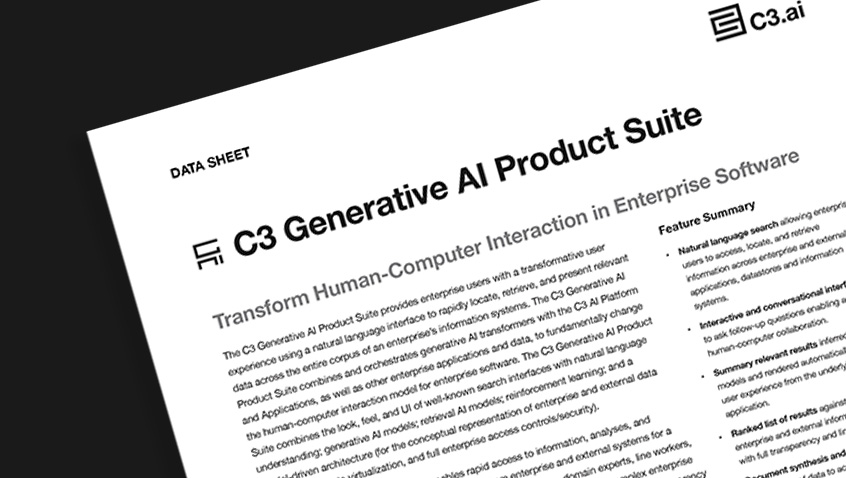- AI Software
- C3 AI Applications
- C3 AI Applications Overview
- C3 AI Anti-Money Laundering
- C3 AI Cash Management
- C3 AI Contested Logistics
- C3 AI CRM
- C3 AI Decision Advantage
- C3 AI Demand Forecasting
- C3 AI Energy Management
- C3 AI ESG
- C3 AI Health
- C3 AI Intelligence Analysis
- C3 AI Inventory Optimization
- C3 AI Process Optimization
- C3 AI Production Schedule Optimization
- C3 AI Property Appraisal
- C3 AI Readiness
- C3 AI Reliability
- C3 AI Smart Lending
- C3 AI Supply Network Risk
- C3 AI Turnaround Optimization
- C3 Generative AI Constituent Services
- C3 Law Enforcement
- C3 Agentic AI Platform
- C3 Generative AI
- Get Started with a C3 AI Pilot
- Industries
- Customers
- Events
- Resources
- Generative AI for Business
- Generative AI for Business
- C3 Generative AI: How Is It Unique?
- Reimagining the Enterprise with AI
- What To Consider When Using Generative AI
- Why Generative AI Is ‘Like the Internet Circa 1996’
- Can the Generative AI Hallucination Problem be Overcome?
- Transforming Healthcare Operations with Generative AI
- Data Avalanche to Strategic Advantage: Generative AI in Supply Chains
- Supply Chains for a Dangerous World: ‘Flexible, Resilient, Powered by AI’
- LLMs Pose Major Security Risks, Serving As ‘Attack Vectors’
- What Is Enterprise AI?
- Machine Learning
- Introduction
- What is Machine Learning?
- Tuning a Machine Learning Model
- Evaluating Model Performance
- Runtimes and Compute Requirements
- Selecting the Right AI/ML Problems
- Best Practices in Prototyping
- Best Practices in Ongoing Operations
- Building a Strong Team
- About the Author
- References
- Download eBook
- All Resources
- Publications
- Customer Viewpoints
- Blog
- Glossary
- Developer Portal
- Generative AI for Business
- News
- Company
- Contact Us
- Generative AI for Business
- Reimagining the Enterprise with AI
- What To Consider When Using Generative AI
- Why Generative AI Is ‘Like the Internet Circa 1996’
- Can the Generative AI Hallucination Problem be Overcome?
- Transforming Healthcare Operations with Generative AI
- Data Avalanche to Strategic Advantage: Generative AI in Supply Chains
- Supply Chains for a Dangerous World: ‘Flexible, Resilient, Powered by AI’
- LLMs Pose Major Security Risks, Serving As ‘Attack Vectors’
- C3 Generative AI: Getting the Most Out of Enterprise Data
- The Key to Generative AI Adoption: ‘Trusted, Reliable, Safe Answers’
- Generative AI in Healthcare: The Opportunity for Medical Device Manufacturers
- Generative AI in Healthcare: The End of Administrative Burdens for Workers
- Generative AI for the Department of Defense: The Power of Instant Insights
- C3 AI’s Generative AI Journey
- What Makes C3 Generative AI Unique
- How C3 Generative AI Is Transforming Businesses
The Key to Generative AI Adoption: ‘Trusted, Reliable, Safe Answers’
December 1, 2023

It’s been about a year since OpenAI unleased ChatGPT to the public, fueling a wave of excitement, optimism, hype, fear, AI-doomsaying, and political confusion. The hype has settled down (for now), but innovation, investment, and overall progress carries on at a rapid clip.
We’re just beginning to see glimpses of how this remarkable technology will reshape business, government, and society at large. Already, for instance, there is evidence of tremendous worker productivity gains.
One person playing the generative AI long game — convinced it’s as important as, say, the introduction of mobile or cloud computing — is George Mathew, a managing director of Insight Partners focused on venture stage investments in AI, machine learning (ML), analytics, and data companies.
C3 AI caught up with Mathew to discuss the state of generative AI, and where he sees things going in the next year and beyond.
Let’s start with the watershed moment that was the public launch of ChatGPT in November 2022.
George Mathew: What ChatGPT did was introduce this idea that you can use a generative pre-trained transformer to achieve humanlike reasoning where the GPT can be used for all kinds of general-purpose needs. We’ve seen that ChatGPT can be a copilot to our lives. It can do many things: give us advice, give us ideas in terms of what we’re thinking about writing or presenting. It almost becomes an advisor to how we live. And we’re finding that these capabilities are enabling us to be more productive in our personal and work lives.
In terms of work, are you referring to the recent paper about worker productivity co-authored by Ethan Mollick of Wharton?
The Ethan Mollick paper was a pretty compelling indicator, showing that ChatGPT has been a massive productivity driver for enterprises, consumers, and society in general. In that study, BCG consultants were working in a group using GPT and the control group was not using GPT. Those using ChatGPT drove 25% faster task completion, and 12% more tasks were completed. The consultants that had the lowest productivity within BCG became 40% more productive.
This is an indicator that the future of work is changing in remarkable ways. In the 1800s, we saw the emergence of the steam engine drive productivity gains of at least 20%. Many people think this is the level and scale that we’re talking about in the coming decade. And that’s why I think everyone is so excited about what’s ahead.
This is happening even as ChatGPT and other generative AI tools are well-known for problems such as hallucinations?
We started to realize that you can additionally train the right datasets to reduce the number of hallucinations created by these models. And at the same time, we still have to be able to check the work. Some of the outputs could be incomplete or incorrect. And in that case, we still would want to reference other sources.
In the enterprise use cases, what we’re now seeing is the domain-specific capabilities around the use of [LLMs] taking advantage of all the enterprise data that exists inside of an organization, and training domain-specific models for enterprise purposes. So, the confabulations and the hallucinations reduce over time.
What you’re talking about, with enterprise data, is what C3 AI is doing.
Which makes a ton of sense because if you think about where the C3 AI journey has gone for many years now, it’s been able to apply AI at scale and to the enterprise. It only makes sense that now C3 AI has a generative AI set of products and services that really support the reduction of hallucinations, the authenticity of the responses coming back from an enterprise context, and of course, being able to have trusted, reliable, safe answers.
Aren’t these still the key concerns for enterprises considering a generative AI solution?
In a lot of larger enterprises today, when you look at the conversations that CIOs and chief data officers are having, invariably, they’re looking at what the quality of the output is coming back from a generative model and what kind of work is being accomplished.
There’s also an ongoing learning element to the generative models. You typically have a feedback loop that’s either provided by a human or another machine, because we need to monitor those capabilities to understand the performance of those generative models in the wild. Also, there’s a whole line of thinking now that’s come about called model observability, which really tracks the performance, the bias, and the fairness detection surrounding a model in production.
You referenced a survey that found that two-thirds of CEOs have reservations about using AI ethically, responsibly, and compliantly. Say more about this.
It’s still early, and I think we’re going to see additional focused abilities from software providers like C3 AI to be able to deliver trust, reliability, and safety in the solutions that are coming to market. We’ve also seen a number of regulatory concerns emerge, especially when you think about the financial services or the healthcare space. We will see laws coming about in the EU, the U.S., and elsewhere in the world.
There are also people in software focused on providing governance risk compliance on top of or alongside of the observability capabilities I mentioned. The governance compliance piece is to be able to adhere to the current state of regulations, wherever they might be in the world, and understand your AI systems are aligned properly with those regulations. So that’s a very active point of change, and an opportunity to market for folks who are delivering enterprise software.
Do you worry about regulation stifling innovation?
In introducing necessary guardrails, it’s important to ensure that you’re not stifling innovation. But if you’re training a model to do adversarial things like what WormGPT did to empower a number of black hat hackers, we need regulations so that another iteration or something similar doesn’t emerge. Those are clear areas where I think regulatory oversight is going to be important. A lot of this should almost come about on a case-by-case basis.
As you look out, what are the industries or opportunities that excite you most?
We started to look at a few layers where we see continued differentiation in the market. There was a lot of work going on with the original foundation models themselves and the emergence of these domain-specific capabilities. On a vertical basis, the tools and platforms that were necessary to build the generative models, what we’d call LMOps (language-model operations). I think there’s plenty of opportunity to innovate in all of those areas. Right now, we’ve been focused as investors on the tools and platform layer. All of these are great opportunities where we think it’s better to continue to innovate and evolve.
As for industries, it’s hard to imagine an industry where generative AI doesn’t provide significant opportunities.
That’s what we’re noticing and that’s why everyone’s so excited. You look at just about any market today, particularly when it comes to some of the key industries where software has been a significant power-up to this moment. Those industries are also the ones most directly and positively impacted by the emergence of generative AI capabilities. And so, some industries are certainly going to move a little bit slower because they’ve just generally been slower from a technology adoption standpoint. But I think when you look at a lot of the customer-facing industries, whether it be retail or CPG, when you look at some of the industries where there are troves and troves of private data, like financial services or healthcare, independent of whether there’s a regulatory framework around the industry — there’s still a tremendous opportunity to build applications and generate value using a generative AI underpinning.
What about the concern that we’re running out of information?
Well, that’s an area that is interesting to see. In the case of a GPT and GPT-4 in particular as a model, that was about a trillion parameters. So that’s approximately 20% of human knowledge that was publicly available. So, you’re right, we’re going to actually run out of data. Most likely, what will play out is that you’re going to see these models become much more multimodal. The second is that there’s more private data. I see opportunities where private data sources are going to be used particularly to build domain-specific models over time. And that’s where enterprises come in, which is where much of the economic value will come from.



